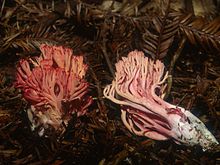Ramaria araiospora
| Ramaria araiospora | |
|---|---|

| |
| Scientific classification | |
| Domain: | Eukaryota |
| Kingdom: | Fungi |
| Division: | Basidiomycota |
| Class: | Agaricomycetes |
| Order: | Gomphales |
| Family: | Gomphaceae |
| Genus: | Ramaria |
| Species: | R. araiospora
|
| Binomial name | |
| Ramaria araiospora Marr & D.E.Stuntz (1974)
| |
Ramaria araiospora, commonly known as the red coral, is a
Taxonomy
The species was first
Description

The fruit bodies of Ramaria araiospora typically measure 5–14 cm (2–5+1⁄2 in) tall by 2–10 cm (3⁄4–3+7⁄8 in) wide.[3] There is a single, somewhat bulbous stipe measuring 2–3 cm (3⁄4–1+1⁄8 in) long by 1.5–2 cm (5⁄8–3⁄4 in) thick,[3] which is branched up to six times. The branches are slender, usually about 1–5 mm (1⁄16–3⁄16 in) in diameter, while branches near the base are thicker, up to 4 cm (1+5⁄8 in) thick. The terminal branches are forked or finely divided into sharp tips. The context is fleshy to fibrous in young specimens, but becomes brittle when dried. The branches are red initially, fading to a lighter red in maturity, while the base, including the stipe, is white to yellowish-white. Branch tips are yellow. When dried, fruit bodies become yellowish white in the base and dull red in the branches. The fruit bodies have no distinctive taste or odor.[1]
In
| Ramaria araiospora mycorrhizal |
|---|
Edibility
Ramaria araiospora fruit bodies are edible,[2] but can result in an upset stomach.[4] In the Villa del Carbón municipality of Mexico, where they are known locally as patitas de pájaro ("bird's legs"), patitas temblonas ("trembling legs"), or patitas rojas ("red legs"), the fungi are favored for their fleshy consistency, mild flavor, and abundance. They are usually sold in lots averaging 480 grams (17 oz) (containing about 15 fruit bodies), at a price between $10 and 20 USD.[5]
Habitat and distribution
Although it is not known with certainty, the species is probably
Similar species
Ramaria stuntzii is similar in appearance, with a larger base, reddish-orange branches below, and is amyloid (unlike R. araiospora).[3] R. cyaneigranosa is also similar, varying mostly in microscopic details.[10]
References
- ^ a b c d e Marr CD, Stuntz DE (1973). Ramaria of Western Washington. Bibliotheca Mycologica. Vol. 38. Lehre, Germany: von J. Cramer. pp. 55–7.
- ^ ISBN 978-0-89815-169-5.
- ^ OCLC 797915861.
- ISBN 978-1-55407-651-2.
- ^ Aguilar-Cruz Y, Villegas M (2010). "Especies de Gomphales comestibles en el municipio de Villa del Carbon Estado de Mexico" [Edible Gomphales from Villa del Carbon municipality, Estado de Mexico]. Revista Mexicana de Micologia (in Spanish). 31: 1–8.
- ^ a b c Kuo M. (April 2007). "Ramaria araiospora". MushroomExpert.com. Retrieved 2012-10-21.
- ^ Phillips R. "Ramaria araiospora var. araiospora". RogersMushrooms. Retrieved 2012-10-21.
- S2CID 133874319.
- ISSN 0187-3180.
- ISBN 978-0-88192-935-5.
